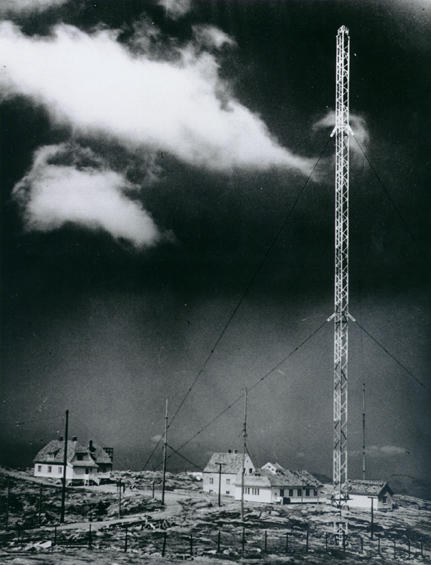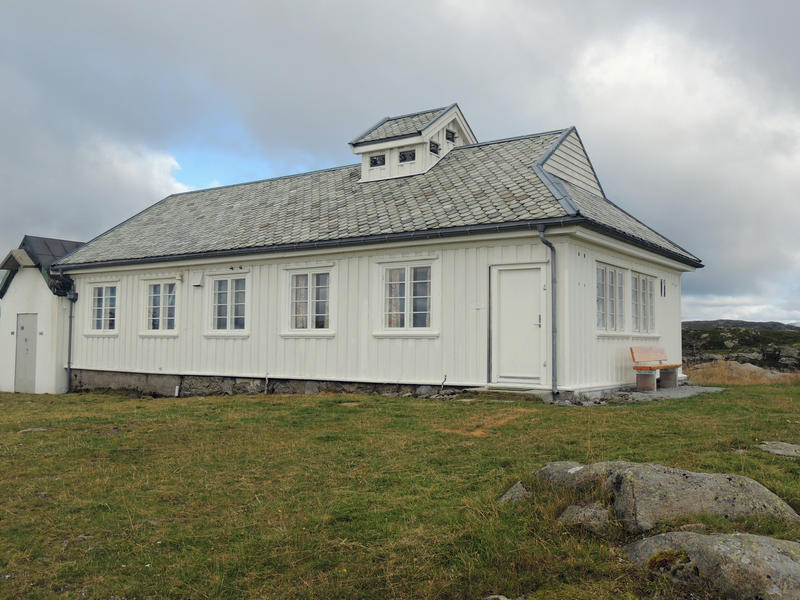- 1/1
Telemuseet
There are few things more Bergen-like than the mountains around it. Not only do they force the clouds to produce masses of rain, but they also provide the best vantage point over the city. All seven mountains (although some claim there are as many as nine) are popular tourist destinations, and second only to Ulriken, is Rundemanen (568 MAMSL) in providing the most exhilarating incline. If you reach the top, however, there is a reward waiting: An old building in the national romantic style, with an exciting history. This was Norway’s first long distance coastal radio.
- 1/1
Ukjent/Telemuseet
Coastal radio of 1912
In 1911 it was decided that Bergen radio would be built on Rundemanen. The Parliament granted 80.000 NOK, and in September 1912 the station was officially opened. Running a coastal radio station was a societal assignment imposed on Telenor (Norges Telegrafvæsen) by the state, mainly to improve on safety at sea. With Bergen radio it became possible to make direct contact with ships and crew via a 5 kW spark transmitter from Telefunken. In 1922 it was replaced by a 4.5kW transmitter equipped with radio valves, the first of its kind in Europe.
Up to 1960 there was a steady increase of activity inside the white painted station building. The number of transmitted telegrams in 1913 was approx. 1400, but in 1959-60 this number had risen to over 530.000. The work done by telegraphers and technicians in the coastal radio service was important, also for safety at sea. After the First World War, minister Stuevold Hansen, wanted to give the employees a gift as a thank you for their effort to aid the vessels out in the North Atlantic. So, what did they wish for? A piano!

Rundemanen, 565 meter over havet, egnet seg ypperlig for en radiostasjon. Stedet lå utenfor rekkevidden for fiendtlige «panserskipskanoner» og hadde stor rekkevidde for signaler.
A whole community had emerged here on top of the mountain. At one point, as many as 25 people lived on the top of Rundemanen, and several of them were children. Those who were of school age had to walk the gravel path to another mountain top, Fløyfjellet, every day, and take the funicular down to the Christi Krybbe School. But where did they all live? Originally there were more houses up on the mountain plateau. Radio telegraphers, technicians, a care taker, a cook and other staff were all lodging in a two storey functionary residence, which unfortunately was demolished in 1982. The house contained a manager’s apartment and a canteen on the ground floor, and flats on the first floor. All rooms were equipped with electricity, and there was a bathtub in the cellar. Water was pumped up from a pond nearby. The sewer was released directly out into the terrain. It must have been a hard life, not least due to the weather seeing as they were completely unprotected from stormy gusts.
“A female functionary was leaving the canteen after finishing her dinner. It couldn’t have been more than 100 metres, but there was a storm blowing. The man who was meant to be relieved from duty, as he was also meant to have is dinner, called after an hour to ask where the next shift had gone to. They had to go out and look for her, and then they found her stuck to the wall. She had been taken by the storm and pinned to the wall, screaming. The howling winds had prevented them from hearing her. The girls in those days wore long dresses, which in this case turned into a sail. She was stuck to the wall like a fly.”
This story originates from a recording done by the Norwegian Telecom Museum, based on an interview with Hans Kjenne who worked at Bergen radio from 1952 to 1959. It is one of several sound clips available to the passer by on a free mobile guide at Rundemanen.
Competence among the employees at Bergen radio was high. In 1927 they constructed a short wave transmitter and antenna equipment themselves, and took the initiative to send telegrams in the short wave spectrum (HF). On the 11 February 1927, Bergen radio received Norway’s first telegram over HF, sent from the whaler Sir James Clark Ross in the Antarctic, approx. 7000 nautical miles away.
Already in 1925 a separate receiving station was established in Fyllingsdalen, so that the facility at Rundemanen could become a pure transmitter station, and thereby significantly reduce its number of staff. After the Second World War the receiving station was moved to Helleneset. In 1960 the short wave service was transferred to Rogaland radio, while Rundemanen continued as transmitter station for telephone and telegraph on medium wave, and from the beginning of the 60s, also VHF. The station was manned up till 1982, when the canteen and functionary building was demolished. The station building and machine house, however, was left standing. The two houses were served protection orders in 2007.
After many years without maintenance, the exterior of the buildings were restored in 2011. At this point, the Norwegian Telecom Museum started comprehensive restoration work, funded by Telenor.
Facts:
- The building is today owned by the Norwegian Telecom Museum.
- Year of construction: 1912
- Operations shut down in 1982.
- Protected in 2007
- Restored in 2011
- Base area: transmitter station: 75 sq. metres, machine house: 20 sq. metres
Sources:
- Norwegian Telecom Museum Rundemanen transmitter station, short history Url: http://www.jankrogh.com/kystradio/stasjonshistorie.htm
- Url: http://www.jankrogh.com/kystradio_i_norge.htm
- Url: http://www.bt.no/nyheter/lokalt/Skal-sikre-radiohistorien-140386b.html
- Url: http://www.laguide.no/rundemanen/

